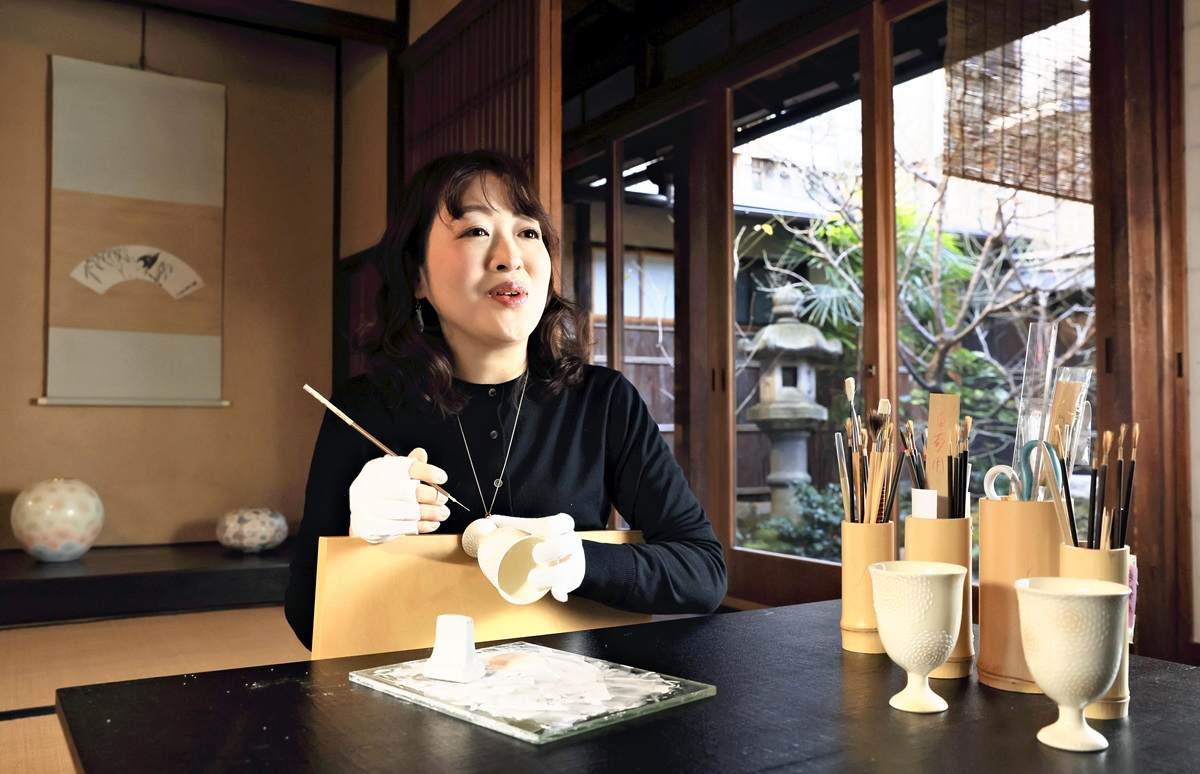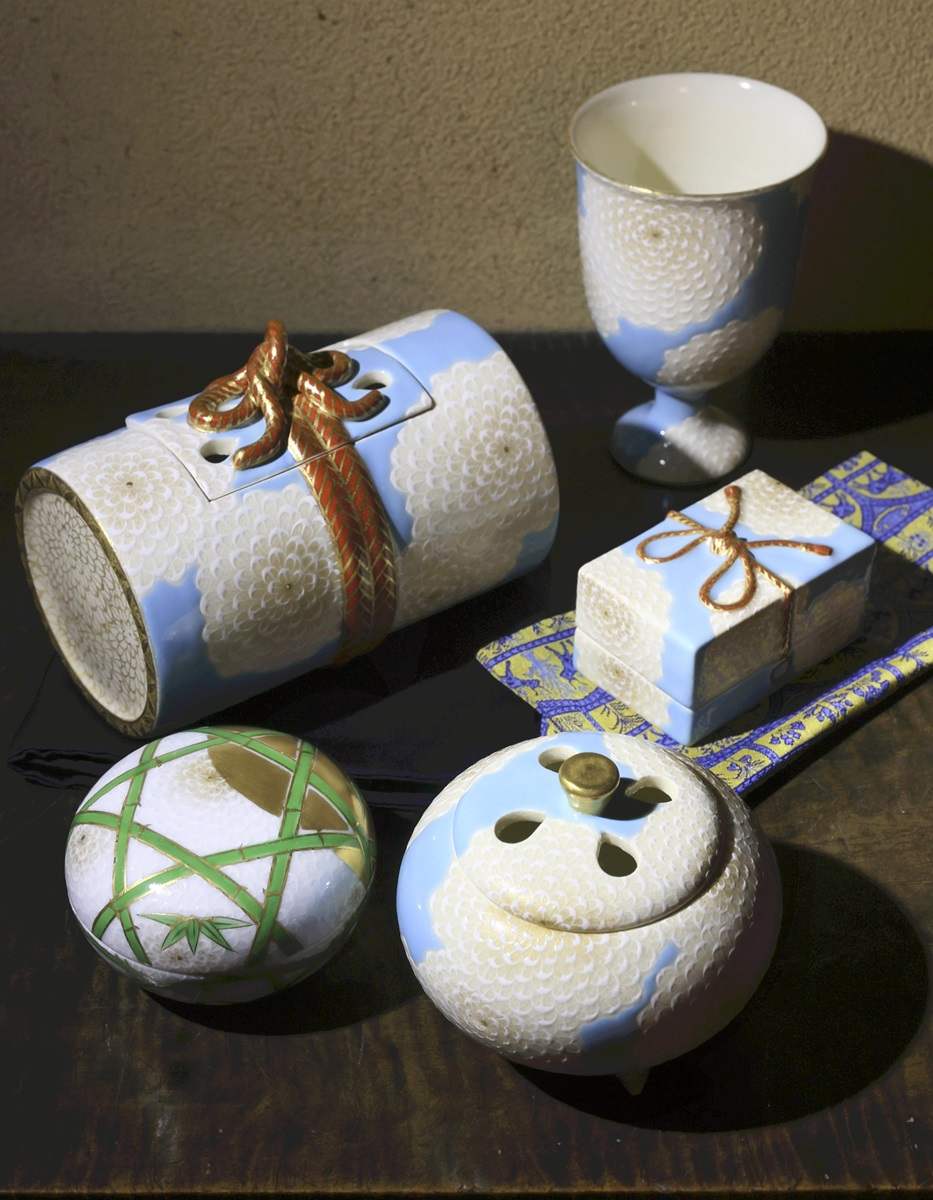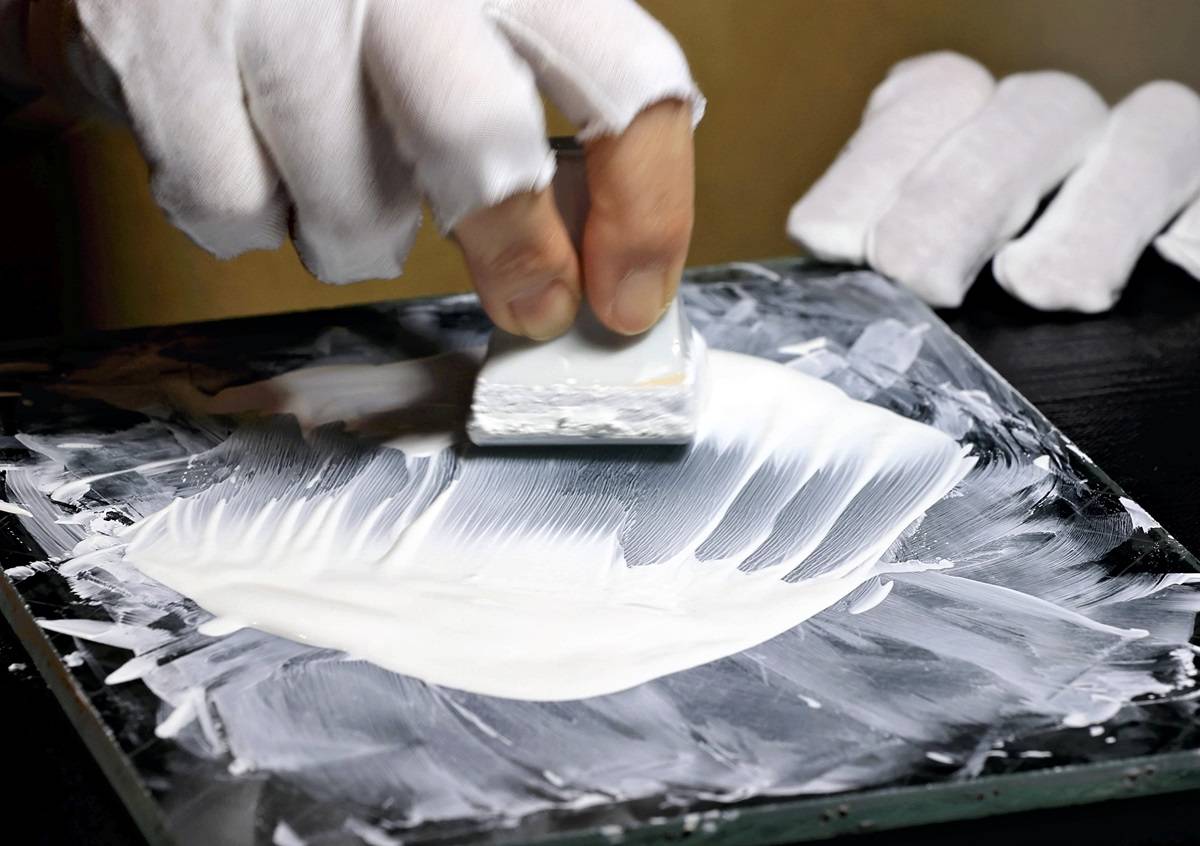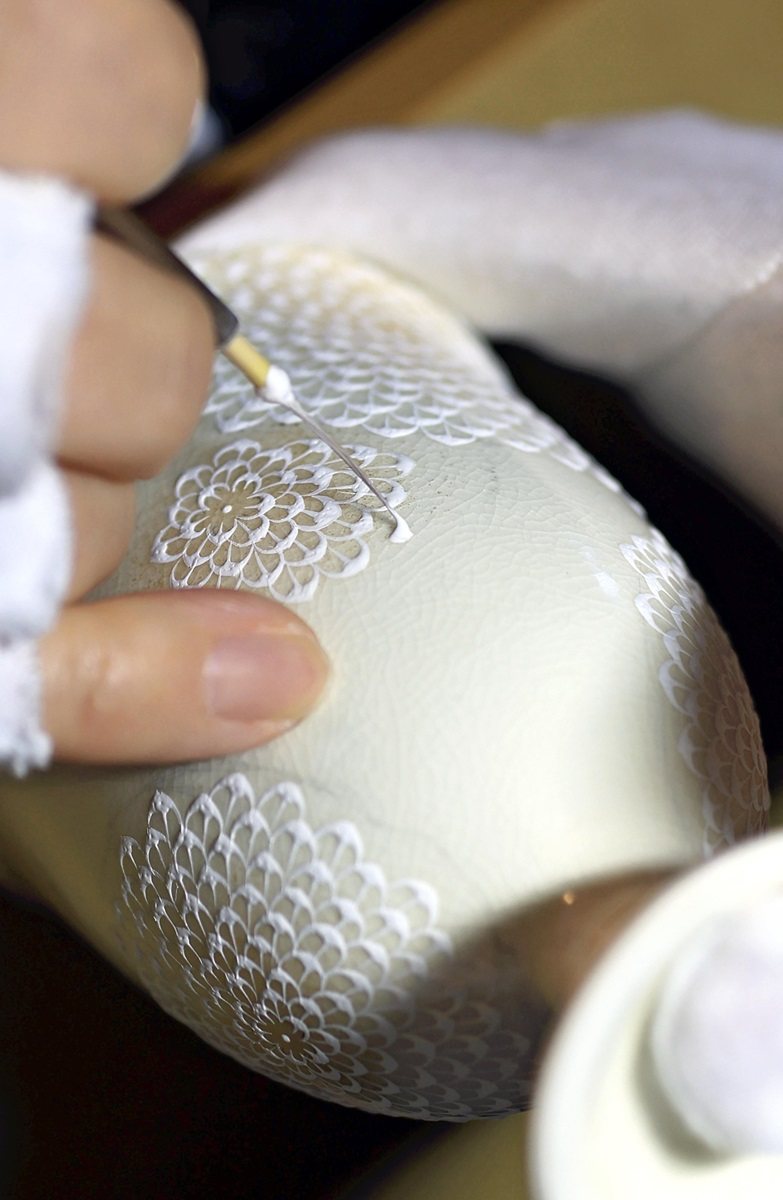
Tae Uesaka talks about her passion for ceramics in Kamigyo Ward, Kyoto.

11:45 JST, March 9, 2024
KYOTO — Every time ceramic artist Tae Uesaka sets her brush on a piece of pottery, it seems to be gaining life.
As she brushes the clay surface of the pottery with a pointed brush tip like a needle, petals of a chrysanthemum are formed, one by one.
Uesaka is a painter for Kyoto’s traditional ceramics. Her design “Shiragiku Sokyu” means “white chrysanthemum and blue sky,” depicting pretty white chrysanthemums as if floating against a clear blue sky like clouds.
She is an artist currently drawing acclaim as she has won numerous awards for tea bowls and cups decorated with the Shiragiku Sokyu design.

An incense burner and other items featuring white chrysanthemum with a blue sky background and a box for sweets, bottom left, inspired by an old Japanese tale
“I’ve loved looking at the sky since I was a child,” said Uesaka, with a smile as she paused her breathtaking work.
Born in Gunma Prefecture, Uesaka worked in the apparel industry after graduating from high school. She later ran a restaurant in her hometown. Then she faced a serious, life-threatening illness before jumping into the world of ceramics.
One morning at the age of 29, she was struck by an unusual headache. Her limbs were paralyzed, and she went blind in her left eye. She was rushed to the hospital, where she underwent emergency surgery for a ruptured brain tumor.
“I thought my life was over since I heard someone say, ‘It’s too late.’ I was able to come back with cardiopulmonary resuscitation,” she said.
Even after her condition improved, she was in and out of the hospital for a while.
Becoming an apprentice
Uesaka had an unexpected encounter with Kiyomizuyaki ware one day when she was watching TV. A program was showing the important cultural property “Iroe Keshimon Chatsubo” (tea-leaf jar decorated with poppies) by Nonomura Ninsei, a pottery master in Kyoto in the 17th century.
Ceramics and porcelain produced in kilns in Kyoto are collectively called Kyo ware and Kiyomizu ware.
When she saw the painting of poppies colored in gold, silver and red, she trembled as if the blood in her body flowed backwards.
“‘How beautiful,’ I thought. The moment I saw it, I knew I was going to do this job,” she said.
Uesaka went to Kyoto to visit Zensho Yamaoka, a potter who had appeared on the program.
When she visited his studio after making repeated requests, she asked to become his apprentice.
Although rejected initially, she did not give up. While studying at a vocational training school for ceramics among other places, she was eventually allowed to become his apprentice.

Paint is dissolved until smooth.

Petals are painted one by one on an item.
Uesaka was given the pseudonym “Zenmyo” after three years of working under Yamaoka and began her career as an independent artist five years ago.
Kyoto pottery produced numerous master potters such as Nonomura Ninsei, Ogata Kenzan, porcelain pioneer Okuda Eisen and Aoki Mokubei, all from the 17th to 19th centuries. Their styles are diverse, including ones with gorgeous colored paintings and simple ones expressed only with glaze.
Uesaka works with traditional color painting like the style of Ninsei, which is her starting point. She paints the vessels with Japanese pigments, plus gold and silver, and then fires them in an electric kiln. This process is repeated several times to create vividly colored paintwork with a three-dimensional effect.
In Kyoto, pottery work is often divided into different divisions of labor, such as forming, painting and firing vessels. Although Uesaka has craftsmen make vessels as she designs their shape, she handles all the other processes, including planning, painting, firing and selling the pieces.
She creates tea bowls, incense burners, sake cups, cups, pendants and interior ceramic panels; her works have won prizes at Kyoto pottery exhibitions and the national traditional crafts competition.
Impact of illness, hardships
Her ideal is to realize the world of beauty, which was expressed by master craftsmen and painters such as Ninsei, Ogata Korin and other artists in his school, as well as Ito Jakuchu. She is prepared to take responsibility for traditional crafts in Kyoto, but she is not obsessive about it.
“I enjoy what I do. I’m just grateful to be able to do my job,” she said.
She feels that not only her devotion to gaining the skills but also the hardships she experienced up until now — even the serious illness she had — have also enriched her art-making practice.

A box for sweets painted with the glow of dusk
Uesaka said that when she was on her sickbed, she thought about what she would do if she regained her ability to move. She desired to use the life she had been given to find something to do and live each day as best as she could.
“Then, I really found something — a job I could devote my life to,” she said.
***
If you are interested in the original Japanese version of this story, click here.
"Features" POPULAR ARTICLE
-

Sanrio to Open Museum in Yamanashi Pref. Dedicated to Founder, Exhibits Include Hello Kitty, Other Characters
-

Autumn Foliage Surrounds Visitors to Tokyo’s Showa Kinen Park
-

My Daughter No Longer Speaks to Me, But I Want to See Her and My Grandchild
-

Kumamoto: Public Bath Refurbished as Library Where You Can Chat, Take Photos
-

Frozen Vegetables: Demand Rises for Convenient, Tasty Domestic Produce
JN ACCESS RANKING
-

Keidanren Chairman Yoshinobu Tsutsui Visits Kashiwazaki-Kariwa Nuclear Power Plant; Inspects New Emergency Safety System
-

Imports of Rare Earths from China Facing Delays, May Be Caused by Deterioration of Japan-China Relations
-

University of Tokyo Professor Discusses Japanese Economic Security in Interview Ahead of Forum
-

Japan Pulls out of Vietnam Nuclear Project, Complicating Hanoi’s Power Plans
-

Govt Aims to Expand NISA Program Lineup, Abolish Age Restriction
























